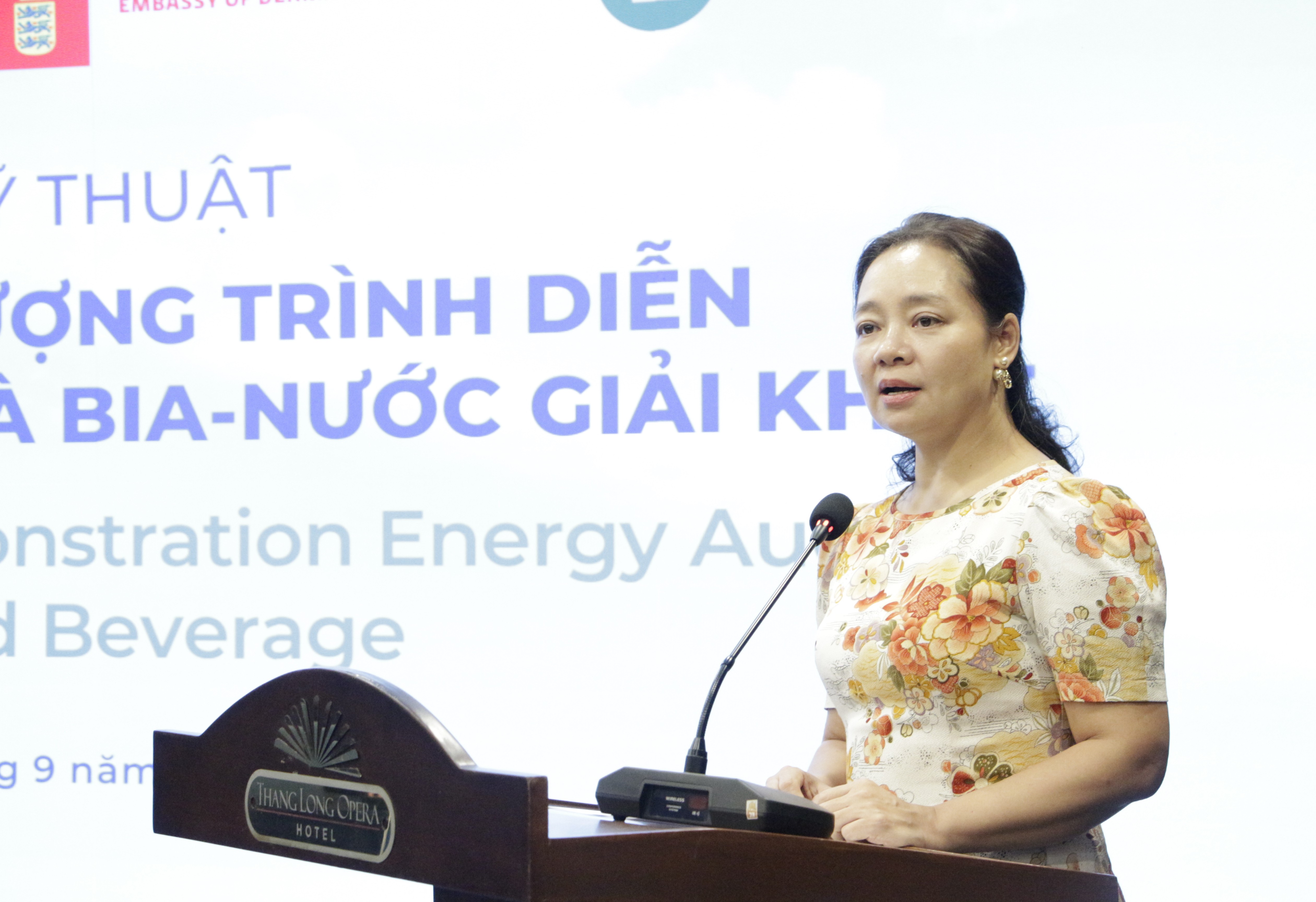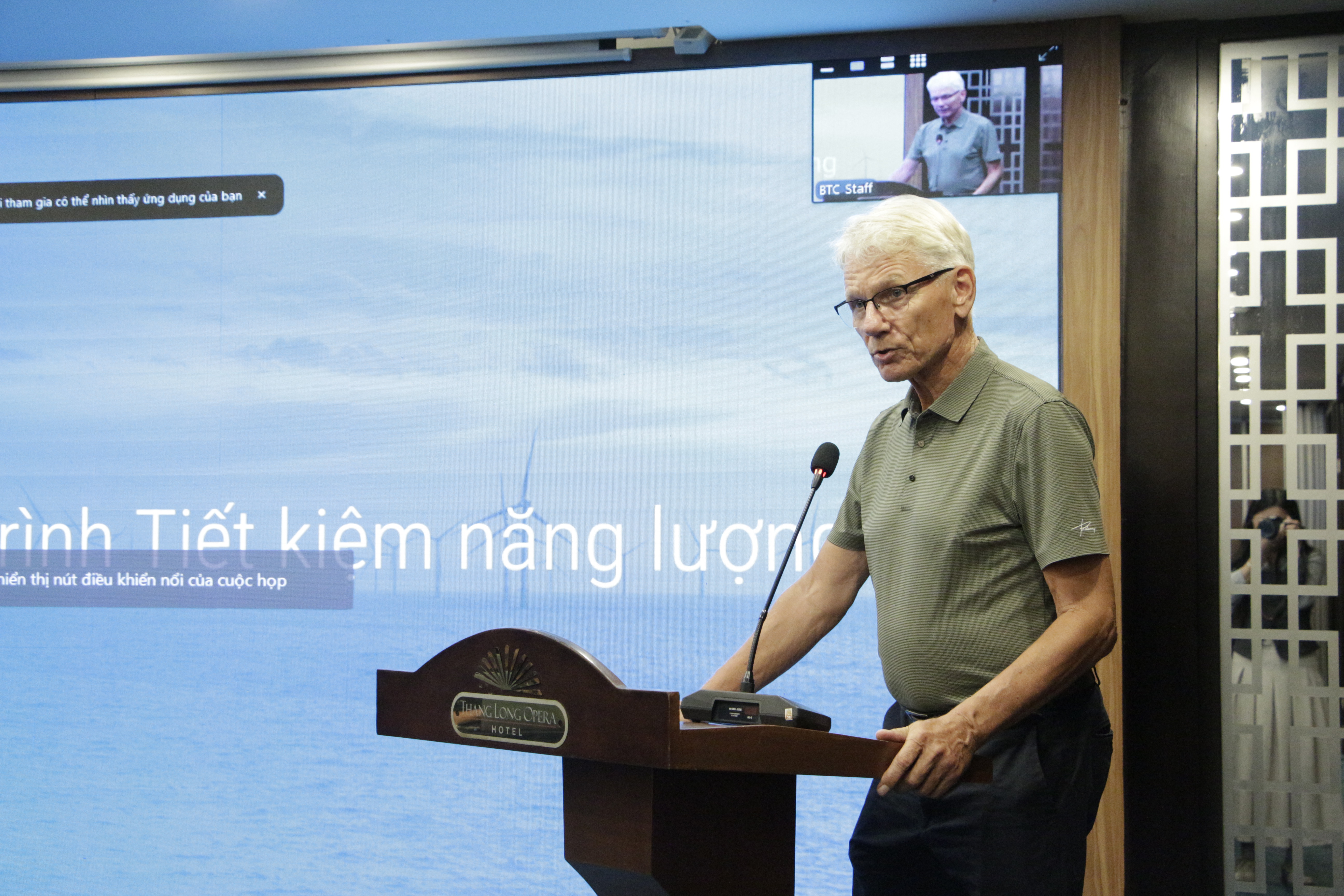Within the framework of Component 3 of the Vietnam - Denmark Energy Partnership Program for the period 2020 – 2025 (DEPP3), on September 23 and 25, the Agency for Innovation, Green Transition and Industry Promotion (MOIT), in collaboration with the Danish Energy Agency (DEA) and the Embassy of Denmark, organized two technical meetings in Hanoi and Ho Chi Minh City to share technical best practices on energy auditing in the ceramics, beer & beverage, steel, and fertilizer industries.
In her opening remarks, Ms. Nguyen Thi Lam Giang, Director General of the Agency for Innovation, Green Transition and Industry Promotion, stated: The economical and efficient use of energy has become an urgent need, not only in Viet Nam but worldwide. Energy audit activities would help enterprises optimize their energy management and operations, identify investment opportunities for energy efficiency solutions, and thereby optimizing energy use, reduce greenhouse gas emissions, and promote the green transition.
Ms. Nguyen Thi Lam Giang, Director General of the Agency for Innovation, Green Transition and Industry Promotion delivered the opening remarks.
119 energy efficiency projects help save 197.4 GWh/year
At the meeting, Mr. Jorgen Hvid, Long-term Advisor to DEPP3 Program, provided an overview of DEPP3 and forms of support available to Viet Nam in the field of sustainable energy. Accordingly, DEPP3 prioritizes promoting energy efficiency solutions in industry through key initiatives such as the Voluntary Agreement Scheme on Energy Efficiency in Energy Intensive Industries (VAS Program) and the operational implementation of the Center of Excellence for Energy Efficiency (CoE). These activities offer new methods for providing technical and financial support and capacity building to enterprises, aiming for green and sustainable development.
Mr. Jorgen Hvid, Long-term Advisor to DEPP3 Program, provided an overview of DEPP3.
Sharing the initial results of energy auditing within the DEPP3 Program, Mr. Rahul Raju Dusa, Special Advisor at the Danish Energy Agency, reported: As of August 2025, through the development of international standard energy audit reports, the program has identified a total of 119 energy efficiency projects, of which 63% relate to electricity and 37% relate to heat, with an energy efficiency potential of 197.4 GWh/year, the majority (79%) being thermal energy savings.
In the energy audit projects under the DEPP3 Program, Danish and Vietnamese experts used new methods and tools to conduct audits according to international standards, notably energy mapping, which provides a comprehensive overview of energy flows in factories, helping identify losses and propose effective investment solutions. |
International standard energy audits: Findings and lessons learned
Regarding specific findings during the audit in the ceramics industry, Mr. Hoa Thai Thanh, Energy Auditor at Viet Nam Technology Solutions Joint Stock Company (VETS), shared that during audits at enterprises, 22 solutions were identified, ranging from compressed air, heat, electricity, automation, to renewable energy. Some solutions under consideration for pilot implementation include: (1) Installing inverter to control fan system faster and rapid drying of 2nd line; (2) Utilizing residual heat for the fluidized bed furnace; (3) Replacing LPG vaporizer; (4) Replacing the 1st line's spray drying tower; and (5) Applying the ISO 50001 Energy Management System.
For the beer and beverage industry, Dr. Trinh Viet Thieu, Energy Expert from PolyTechnical Energy and Environment Joint Stock Company (POLYTEE), presented the audit results at HABECO ID’s plant (capacity: 50 million liters/year), where audits were conducted in line with technical guidance and energy mapping to comprehensively assess energy flows. Based on the audit results, the consulting team proposed feasible solutions: installing a water heater using boiler flue gas, converting coal-fired boilers to biomass, removing fouling in the cooling tower, utilizing waste cold released from CO2 evaporation, using solar lighting, and installing variable frequency drive (VFD) for air compressors. These solutions could save around 250,000 kWh of electricity and nearly 600 tons of coal annually, while cutting about 1,300 tonnes of CO2.
Mr. Ha Duc Toan, representative of CTH Ceramics Joint Stock Company (Phu Tho), stated: “Thanks to the VAS project, our company has optimized energy consumption, improved processes, and implemented practical measures such as installing rooftop solar power system, adjusting the air compressor's operating mode, insulating fluidized bed furnace's doors, installing time relays for the stirring motor system in the glaze tanks, and installing VSD for motor systems.” |
In the steel industry, auditors from the Energy Conservation Research and Development Center (ENERTEAM) reported that melting processes account for over 90% of total electricity consumption at a demonstration enterprise. Energy mapping helped identify many losses, leading to proposed energy efficiency investment projects, notably two level A (high investment and technical complexity) solutions: investing in scrap shredding machines (saving nearly 3 million kWh/year, reducing up to 1,800 tCO2e/year) and installing rooftop solar system (saving about 3.5 million kWh/year, reducing over 2,000 tCO2e/year).
As for the fertilizer industry, the demonstration energy audit carried out by ECC Bach Khoa at PetroVietnam Ca Mau Fertilizer Joint Stock Company indicated a large amount of waste heat (50-150°C) is being released into the environment. Proposed solutions include improving cooling systems, optimizing heat exchangers, using VSDs to control the capacity of large pumps and fans, utilizing Delta-T-hunting and improved heat recovery, or applying ORC technology to increase power production.
Mr. Nguyen Truong Giang, representative of PetroVietnam Ca Mau Fertilizer Joint Stock Company (PVCFC), assessed: “Participating in DEPP3 allows us to benchmark our performance against international standards and confirms that by optimizing cooling and heat recovery systems, the company could save up to USD 2 million in energy costs annually and reduce CO2 emissions by tens of thousands of tonnes.” |
During the two seminars, delegates also spent time discussing the practical application of energy audit reports in implementing energy efficiency solutions in enterprises. These opinions not only provided important suggestions for improving the quality of audit reports but also emphasize the importance of enhancing coordination among stakeholders in the journey towards green and sustainable development.
Reference materials and photos from the seminars are available at:
- Technical meeting on demonstration energy audits in ceramic and beverage: Documents - Photos - Technical meeting on demonstration energy audit in steel and fertilizer industries: Documents - Photos DEPP3 Program



